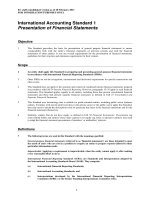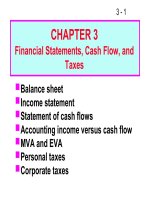bài giảng chapter 1 overview of financial management and the financial environment
Bạn đang xem bản rút gọn của tài liệu. Xem và tải ngay bản đầy đủ của tài liệu tại đây (129.12 KB, 49 trang )
1 - 1
CHAPTER 1
Overview of Financial Management
and the Financial Environment
Financial management
Forms of business organization
Objective of the firm: Maximize wealth
Determinants of stock pricing
The financial environment
Financial instruments, markets and
institutions
Interest rates and yield curves
1 - 2
Why is corporate finance important to
all managers?
Corporate finance provides the skills
managers need to:
Identify and select the corporate
strategies and individual projects
that add value to their firm.
Forecast the funding requirements
of their company, and devise
strategies for acquiring those
funds.
1 - 3
Sole proprietorship
Partnership
Corporation
What are some forms of business
organization a company might have as
it evolves from a start-up to a major
corporation?
1 - 4
Advantages:
Ease of formation
Subject to few regulations
No corporate income taxes
Disadvantages:
Limited life
Unlimited liability
Difficult to raise capital to support
growth
Starting as a Sole Proprietorship
1 - 5
A partnership has roughly the same
advantages and disadvantages as a
sole proprietorship.
Starting as or Growing into a
Partnership
1 - 6
Becoming a Corporation
A corporation is a legal entity
separate from its owners and
managers.
File papers of incorporation with
state.
Charter
Bylaws
1 - 7
Advantages:
Unlimited life
Easy transfer of ownership
Limited liability
Ease of raising capital
Disadvantages:
Double taxation
Cost of set-up and report filing
Advantages and Disadvantages of a
Corporation
1 - 8
Becoming a Public Corporation and
Growing Afterwards
Initial Public Offering (IPO) of Stock
Raises cash
Allows founders and pre-IPO investors
to “harvest” some of their wealth
Subsequent issues of debt and equity
Agency problem: managers may act in
their own interests and not on behalf of
owners (stockholders)
1 - 9
The primary objective should be
shareholder wealth maximization,
which translates to maximizing stock
price.
Should firms behave ethically? YES!
Do firms have any responsibilities to
society at large? YES! Shareholders
are also members of society.
What should management’s primary
objective be?
1 - 10
Is maximizing stock price good for
society, employees, and customers?
Employment growth is higher in firms
that try to maximize stock price. On
average, employment goes up in:
firms that make managers into
owners (such as LBO firms)
firms that were owned by the
government but that have been sold
to private investors
1 - 11
Consumer welfare is higher in
capitalist free market economies
than in communist or socialist
economies.
Fortune lists the most admired firms.
In addition to high stock returns,
these firms have:
high quality from customers’ view
employees who like working there
1 - 12
Amount of expected cash flows
(bigger is better)
Timing of the cash flow stream
(sooner is better)
Risk of the cash flows (less risk is
better)
What three aspects of cash flows
affect an investment’s value?
1 - 13
What are “free cash flows (FCF)”
Free cash flows are the cash flows
that are:
Available (or free) for distribution
To all investors (stockholders and
creditors)
After paying current expenses,
taxes, and making the investments
necessary for growth.
1 - 14
Determinants of Free Cash Flows
Sales revenues
Current level
Short-term growth rate in sales
Long-term sustainable growth rate in
sales
Operating costs (raw materials, labor,
etc.) and taxes
Required investments in operations
(buildings, machines, inventory, etc.)
1 - 15
What is the weighted average cost of
capital (WACC)?
The weighted average cost of capital
(WACC) is the average rate of return
required by all of the company’s
investors (stockholders and
creditors)
1 - 16
What factors affect the weighted
average cost of capital?
Capital structure (the firm’s relative
amounts of debt and equity)
Interest rates
Risk of the firm
Stock market investors’ overall
attitude toward risk
1 - 17
What determines a firm’s value?
A firm’s value is the sum of all the
future expected free cash flows when
converted into today’s dollars:
∞
∞
+
+
+
+
+
=
)WACC1(
FCF
)WACC1(
FCF
)WACC1(
FCF
Value
2
2
1
1
1 - 18
What are financial assets?
A financial asset is a contract that
entitles the owner to some type of
payoff.
Debt
Equity
Derivatives
In general, each financial asset
involves two parties, a provider of
cash (i.e., capital) and a user of cash.
1 - 19
What are some financial instruments?
Instrument Rate (April 2003)
U.S. T-bills 1.14%
Banker’s acceptances 1.22
Commercial paper 1.21
Negotiable CDs 1.24
Eurodollar deposits 1.23
Commercial loans Tied to prime (4.25%)
or LIBOR (1.29%)
(More . .)
1 - 20
Financial Instruments (Continued)
Instrument Rate (April 2003)
U.S. T-notes and T-bonds 5.04%
Mortgages 5.57
Municipal bonds 4.84
Corporate (AAA) bonds 5.91
Preferred stocks 6 to 9%
Common stocks (expected)9 to 15%
1 - 21
Who are the providers (savers) and
users (borrowers) of capital?
Households: Net savers
Non-financial corporations: Net
users (borrowers)
Governments: Net borrowers
Financial corporations: Slightly
net borrowers, but almost
breakeven
1 - 22
Direct transfer (e.g., corporation issues
commercial paper to insurance company)
Through an investment banking house
(e.g., IPO, seasoned equity offering, or
debt placement)
Through a financial intermediary (e.g.,
individual deposits money in bank, bank
makes commercial loan to a company)
What are three ways that capital is
transferred between savers and
borrowers?
1 - 23
Commercial banks
Savings & Loans, mutual savings
banks, and credit unions
Life insurance companies
Mutual funds
Pension funds
What are some financial intermediaries?
1 - 24
The Top 5 Banking Companies
in the World, 12/2001
Bank Name Country
Citigroup U.S.
Deutsche Bank AG Germany
Credit Suisse Switzerland
BNP Paribas France
Bank of America U.S.
1 - 25
What are some types of markets?
A market is a method of
exchanging one asset (usually
cash) for another asset.
Physical assets vs. financial assets
Spot versus future markets
Money versus capital markets
Primary versus secondary markets









